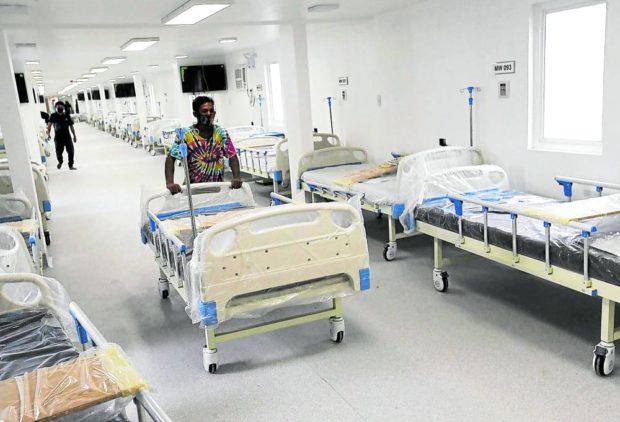DOH: More beds needed than oxygen, ventilators

FIELD HOSPITAL Workers arrange beds in a COVID-19 facility built from repurposed freight containers and set up at the Burnham Green section of Rizal Park across Quirino Grandstand in Manila. The field hospital has a 336-bed capacity. —RICHARD A. REYES
MANILA, Philippines — Hospitals need to allocate more beds for COVID-19 patients, but don’t have much need for ventilators and oxygen, as there are few severe and critical coronavirus cases, according to the Department of Health (DOH).
Health Undersecretary Maria Rosario Vergeire said at Saturday’s Laging Handa briefing that the DOH was “monitoring certain areas that have not allocated enough Covid beds.”
She explained that “in some areas, this is because they have plenty of non-Covid admissions. As for the others, our local governments really do not have the capacity.”
But she noted that “One thing we can see now, which is good, is there [are] not that many [patients] who are severe and critical. So the use of mechanical ventilators, use of oxygen, and use of COVID-19 investigational drugs for severe and critical [cases are] not needed much.”
Vergeire said the health-care utilization rate in most regions is at moderate risk, between 50 and 70 percent.
Virus case update
The department’s latest case bulletin showed that intensive care unit beds in use nationwide were at 52 percent; isolation beds, also at 52 percent; and ward beds, at 53 percent. Ventilators in use nationwide were at 24 percent.
The 30,552 new cases reported on Saturday were lower than Friday’s 32,744. The national caseload was now at 3,387,524, of which 280,619 were active cases.
The DOH said 267,236 of those cases were mild, 8,591 were asymptomatic, 2,996 were moderate, 1,491 were severe and 305 were critical.
Other indicators
The Calabarzon (Cavite, Laguna, Batangas, Rizal and Quezon) region registered the highest number of coronavirus cases at 5,991, slightly higher than the 5,989 in the National Capital Region (NCR). Together, they accounted for 42 percent of the cases nationwide. Central Luzon followed with 2,563 cases (9 percent).
According to the independent OCTA Research group, the average daily attack rate (Adar) in the capital region—or the number of individuals infected per 100,000 population—was 83.93 during the period of Jan. 15 to Jan. 21, a further drop from 93.82 from Jan. 14 to Jan. 20 and 111.47 from Jan. 12 to Jan. 18.
Yet despite that decline, NCR remained under “severe” classification and was certainly way above the acceptable attack rate of below 10, OCTA said.
The capital region’s Adar before the current surge, which began late December last year, was 0.69.
Baguio City recorded the highest Adar to date at 152.65, according to OCTA. Other cities with a very high attack rate are Iloilo (71.62), Cebu (48.88), Lapu-Lapu (44.20), Tacloban (41.88), Angeles (37.53), Lucena (31.45), Davao (30.82) and Cagayan de Oro (27.74).
Benguet topped the provinces in terms of their Adar with 92.71, the latest OCTA figures show. The others are Laguna (61.82), Cavite (59.10), Bataan (53.05), Rizal (51.13), Kalinga (50.39), Mountain Province (40.10), La Union (39.61), Bulacan (32.60), Cagayan (30.62), Nueva Vizcaya (29.89), Pampanga (28.25), Apayao (28.23), Batangas (28.07) and Ilocos Norte (28.04).
The reproduction number, or the number of people a person with COVID-19 can infect, was highest in Davao City at 4.04.
OCTA fellow Guido David also noted “very high” reproduction numbers in the cities of Baguio, Iloilo, Cebu, Lapu-Lapu, Tacloban and Cagayan de Oro, while in Metro Manila, he said it was 1.38.
A reproduction number of less than 1 indicates COVID-19 transmission slowing down.
The DOH bulletin on Saturday showed the positivity rate, or the percentage of tests that came out positive, was at 45.1 percent nationwide, was higher than Friday’s 44 percent. This was based on 68,049 people tested on Thursday.
The World Health Organization’s benchmark positivity rate of below 5 percent, sustained for two weeks, indicates transmission under control.
There were 41,471 new recoveries which brought the total number of survivors to 3,053,499. But 97 new fatalities were also recorded. This raised the death toll to 53,406.
Disclaimer: The comments uploaded on this site do not necessarily represent or reflect the views of management and owner of Cebudailynews. We reserve the right to exclude comments that we deem to be inconsistent with our editorial standards.
